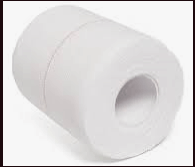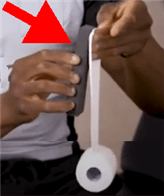The most common reason for rugby players to tape both thighs is to aid with being lifted in a lineout. Tape and bandages on only one thigh are usually to support a minor injury.
This article gives a detailed explanation of using tape for lineout jumpers. We also have a step-by-step pictorial guide on how rugby players bandage their thighs for the lineout. And we’ll cover some of the other reasons for player taping their thighs.
A Quick Explanation Of The Lineout
A lineout is used in rugby to restart play when the ball goes over the sidelines into touch. Players from the opposing teams line up in two rows. Some players jump to catch the ball, and other players lift the jumpers.
Usually, two players do the lifting – one from the front and one from the back.
The lifter starts with his hands on the players shorts while the jumper leaps up. The lifter boosts the player further upward and brings him safely to the ground – hopefully with the ball secured.
Lineouts Without Tape
The lifter at the back has the natural lifting point of the jumper’s buttocks! The lifter at the front might only be able to secure a good grip with a hard squeeze.
That’s what’s going on in this picture. There is no tape on the jumper’s thighs.

A team that can shoot a player high into the air has an advantage at the lineout. That’s difficult to do when gripping bare skin on a wet day and a muddy field.
This is why tape and lifting blocks are used.
Lineouts, Tape and Lifting Blocks
This picture is from a training session with the jumper wearing tape around both thighs. This is a familiar sight if you watch professional rugby on television.

What’s going on? Well, you can’t see the key details when all the tape has been applied!
But there is a piece of foam underneath the taped bandaging at the front of each thigh. This provides a ledge for the lifter to get a better grip.
There are two advantages to using tape and some form of lifting block. The first is to maximize the lift i.e. get greater height to the arc of the jump.
The second advantage is to lift more securely. The better grip means the lifters keep control of the descent of the jumper.
What’s underneath the tape?
If you’re curious as to what the lifting block looks like, lots of manufacturers sell different options. Here is one example of a black foam rectangular block. The player is positioning it on the thigh before applying bandaging and tape to keep it in place.

Which Players Wear Tape For Lineouts?
The players who usually jump in the lineout wear tape. The most typical jumpers in a lineout are the locks or second-row forwards.
However, backrow forwards may also be specialist jumpers. This is often the openside flanker, who tends to be a little lighter and smaller than the blindside and number eight. Some players are simply too heavy to lift.
Where Are Lifting Blocks Taped On Thighs?
The lifting block is taped on the lower thigh. It is usually positioned just above the knee. But some professional players prefer to have it a little higher up.
It’s important not to let the tape cover the top of the knee. This would hinder running. It’s also important not to tie the tape too tightly, as this would also restrict the hamstrings.
What Kind Of Tape Is Used For Lifting In Rugby Lineouts?
There are usually two types of tape used to secure lifting blocks on the thighs:
- Elastic adhesive tape
- Electrical or insulation tape
The elastic adhesive tape sticks the lifting block to the thigh.

The electrical tape keeps the block in position.

How To Tape A Rugby Players Thighs For The Lineout
Here is the three-step illustrated guide to taping your thighs for the lineout.
(1) Position the lineout block on your lower thigh
You have two options.
This player positions the foam with both hands. Then he will hold it in place with one hand and wrap with the other. You can also grab a teammate to make this easier.

Alternatively, the professional player below likes to stick the block to the adhesive tape before applying to the thigh.

(2) Wrap the adhesive tape around the thigh
This pro player is taping the block directly to his skin. He has also shaved his legs to avoid tearing the hairs out when removing the tape!
You may prefer to apply a layer of strapping first – otherwise, it may hurt coming off.

(3) Secure the block in position with the electrical tape
Once the adhesive tape is holding the block in place, the electrical tape is wrapped below and above the block. This completely secures the strapping.

Tape For Minor Thigh Injuries
Occasionally you’ll see a player with one thigh strapped with tape and bandaging. This is a sure sign that the player is carrying an injury. It could be a mild strain or tightness.
But it’s always a worry for rugby supports when a key player runs out onto the pitch with strapping like this!

Especially when it’s the outhalf’s kicking leg.
Kinesiology Tape On Rugby Players
Occasionally you’ll see a rugby player sporting a piece of vertical tape down their thigh. It will start from under their shorts and finish above the knee.

This is probably kinesiology tape and is a crossover from athletics and other sports. The player is usually looking to alleviate tightness and light strains.
Currently, there’s no scientific evidence showing that these special types of tape have special powers.
Video Walkthroughs Of How Rugby Players Bandage Their Thighs
Here are two Youtube videos demonstrating slightly different ways to tape up your thighs for lineouts.
Other Uses For Tape
You’ve probably noticed that players don’t just tape their thighs. You’ll see tape on wrists and heads as well.
If you’re wondering what’s going on, check out these articles:
2 thoughts on “Why Do Rugby Players Tape Their Thighs?”
Comments are closed.